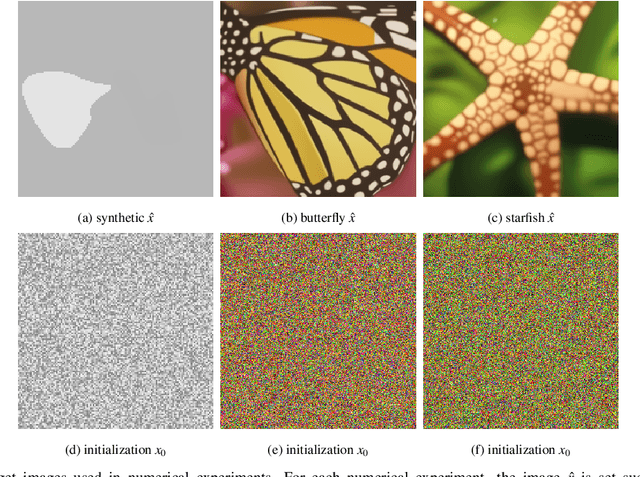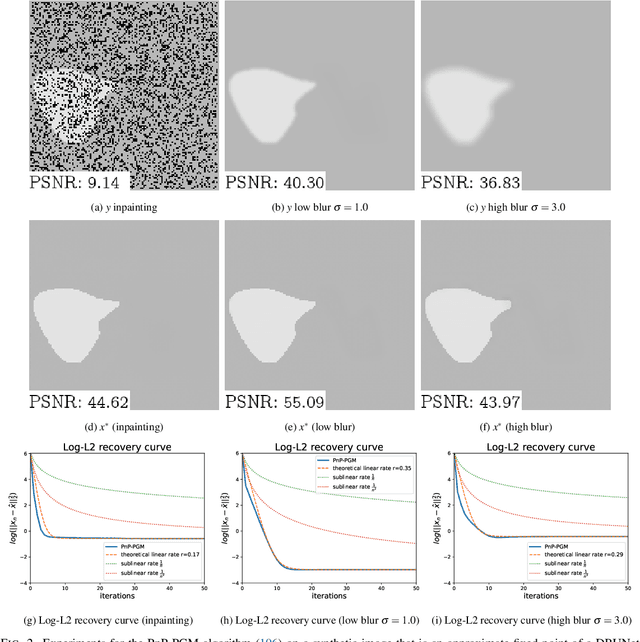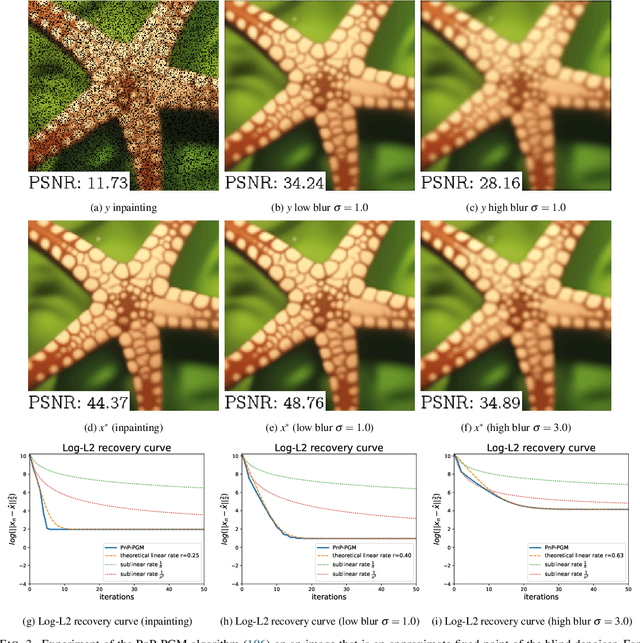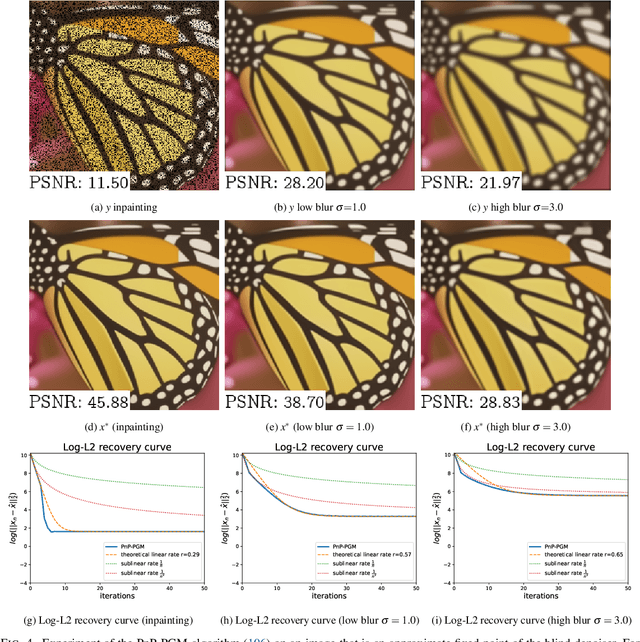Yann Traonmilin
IMB
Parameter-free structure-texture image decomposition by unrolling
Mar 17, 2025Abstract:In this work, we propose a parameter-free and efficient method to tackle the structure-texture image decomposition problem. In particular, we present a neural network LPR-NET based on the unrolling of the Low Patch Rank model. On the one hand, this allows us to automatically learn parameters from data, and on the other hand to be computationally faster while obtaining qualitatively similar results compared to traditional iterative model-based methods. Moreover, despite being trained on synthetic images, numerical experiments show the ability of our network to generalize well when applied to natural images.
Towards optimal algorithms for the recovery of low-dimensional models with linear rates
Oct 09, 2024



Abstract:We consider the problem of recovering elements of a low-dimensional model from linear measurements. From signal and image processing to inverse problems in data science, this question has been at the center of many applications. Lately, with the success of models and methods relying on deep neural networks leading to non-convex formulations, traditional convex variational approaches have shown their limits. Furthermore, the multiplication of algorithms and recovery results makes identifying the best methods a complex task. In this article, we study recovery with a class of widely used algorithms without considering any underlying functional. This result leads to a class of projected gradient descent algorithms that recover a given low-dimensional with linear rates. The obtained rates decouple the impact of the quality of the measurements with respect to the model from its intrinsic complexity. As a consequence, we can directly measure the performance of this class of projected gradient descents through a restricted Lipschitz constant of the projection. By optimizing this constant, we define optimal algorithms. Our general approach provides an optimality result in the case of sparse recovery. Moreover, we uncover underlying linear rates of convergence for some ''plug and play'' imaging methods relying on deep priors by interpreting our results in this context, thus linking low-dimensional recovery and recovery with deep priors under a unified theory, validated by experiments on synthetic and real data.
Batch-less stochastic gradient descent for compressive learning of deep regularization for image denoising
Oct 02, 2023Abstract:We consider the problem of denoising with the help of prior information taken from a database of clean signals or images. Denoising with variational methods is very efficient if a regularizer well adapted to the nature of the data is available. Thanks to the maximum a posteriori Bayesian framework, such regularizer can be systematically linked with the distribution of the data. With deep neural networks (DNN), complex distributions can be recovered from a large training database.To reduce the computational burden of this task, we adapt the compressive learning framework to the learning of regularizers parametrized by DNN. We propose two variants of stochastic gradient descent (SGD) for the recovery of deep regularization parameters from a heavily compressed database. These algorithms outperform the initially proposed method that was limited to low-dimensional signals, each iteration using information from the whole database. They also benefit from classical SGD convergence guarantees. Thanks to these improvements we show that this method can be applied for patch based image denoising.}
Fast off-the-grid sparse recovery with over-parametrized projected gradient descent
Feb 28, 2022



Abstract:We consider the problem of recovering off-the-grid spikes from Fourier measurements. Successful methods such as sliding Frank-Wolfe and continuous orthogonal matching pursuit (OMP) iteratively add spikes to the solution then perform a costly (when the number of spikes is large) descent on all parameters at each iteration. In 2D, it was shown that performing a projected gradient descent (PGD) from a gridded over-parametrized initialization was faster than continuous orthogonal matching pursuit. In this paper, we propose an off-the-grid over-parametrized initialization of the PGD based on OMP that permits to fully avoid grids and gives faster results in 3D.
A theory of optimal convex regularization for low-dimensional recovery
Dec 07, 2021


Abstract:We consider the problem of recovering elements of a low-dimensional model from under-determined linear measurements. To perform recovery, we consider the minimization of a convex regularizer subject to a data fit constraint. Given a model, we ask ourselves what is the "best" convex regularizer to perform its recovery. To answer this question, we define an optimal regularizer as a function that maximizes a compliance measure with respect to the model. We introduce and study several notions of compliance. We give analytical expressions for compliance measures based on the best-known recovery guarantees with the restricted isometry property. These expressions permit to show the optimality of the {\ell} 1-norm for sparse recovery and of the nuclear norm for low-rank matrix recovery for these compliance measures. We also investigate the construction of an optimal convex regularizer using the example of sparsity in levels.
Statistical Learning Guarantees for Compressive Clustering and Compressive Mixture Modeling
Apr 17, 2020
Abstract:We provide statistical learning guarantees for two unsupervised learning tasks in the context of compressive statistical learning, a general framework for resource-efficient large-scale learning that we introduced in a companion paper. The principle of compressive statistical learning is to compress a training collection, in one pass, into a low-dimensional sketch (a vector of random empirical generalized moments) that captures the information relevant to the considered learning task. We explicit random feature functions which empirical averages preserve the needed information for compressive clustering and compressive Gaussian mixture modeling with fixed known variance, and establish sufficient sketch sizes given the problem dimensions.
Compressive Statistical Learning with Random Feature Moments
Dec 07, 2017


Abstract:We describe a general framework --compressive statistical learning-- for resource-efficient large-scale learning: the training collection is compressed in one pass into a low-dimensional sketch (a vector of random empirical generalized moments) that captures the information relevant to the considered learning task. A near-minimizer of the risk is computed from the sketch through the solution of a nonlinear least squares problem. We investigate sufficient sketch sizes to control the generalization error of this procedure. The framework is illustrated on compressive clustering, compressive Gaussian mixture Modeling with fixed known variance, and compressive PCA.
Phase Unmixing : Multichannel Source Separation with Magnitude Constraints
Mar 20, 2017

Abstract:We consider the problem of estimating the phases of K mixed complex signals from a multichannel observation, when the mixing matrix and signal magnitudes are known. This problem can be cast as a non-convex quadratically constrained quadratic program which is known to be NP-hard in general. We propose three approaches to tackle it: a heuristic method, an alternate minimization method, and a convex relaxation into a semi-definite program. The last two approaches are showed to outperform the oracle multichannel Wiener filter in under-determined informed source separation tasks, using simulated and speech signals. The convex relaxation approach yields best results, including the potential for exact source separation in under-determined settings.
Compressive K-means
Feb 10, 2017



Abstract:The Lloyd-Max algorithm is a classical approach to perform K-means clustering. Unfortunately, its cost becomes prohibitive as the training dataset grows large. We propose a compressive version of K-means (CKM), that estimates cluster centers from a sketch, i.e. from a drastically compressed representation of the training dataset. We demonstrate empirically that CKM performs similarly to Lloyd-Max, for a sketch size proportional to the number of cen-troids times the ambient dimension, and independent of the size of the original dataset. Given the sketch, the computational complexity of CKM is also independent of the size of the dataset. Unlike Lloyd-Max which requires several replicates, we further demonstrate that CKM is almost insensitive to initialization. For a large dataset of 10^7 data points, we show that CKM can run two orders of magnitude faster than five replicates of Lloyd-Max, with similar clustering performance on artificial data. Finally, CKM achieves lower classification errors on handwritten digits classification.
 Add to Chrome
Add to Chrome Add to Firefox
Add to Firefox Add to Edge
Add to Edge